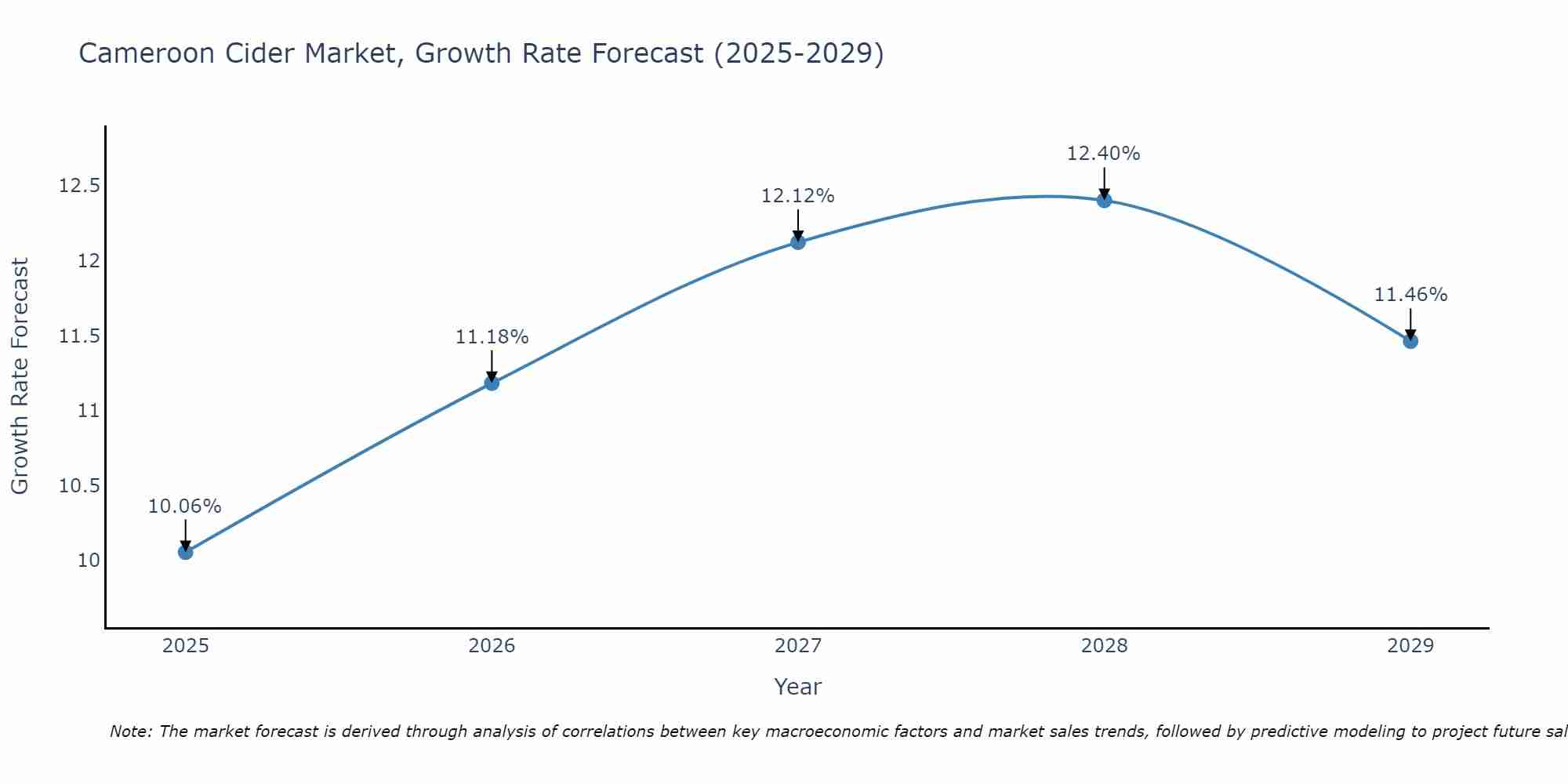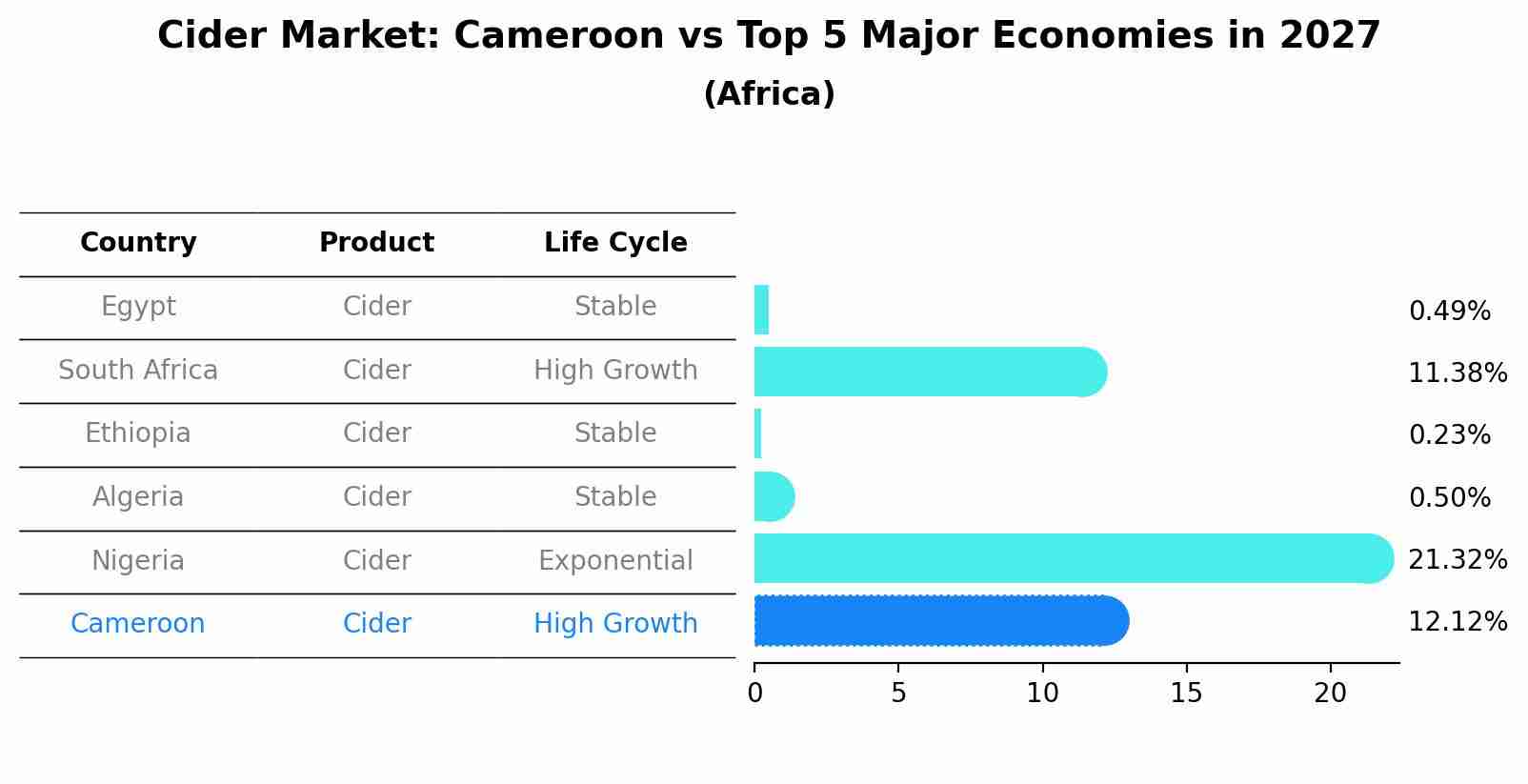Cameroon Cider Market (2025-2031) | Segmentation, Trends, Share, Outlook, Revenue, Companies, Size, Value, Growth, Analysis, Industry & Forecast
| Product Code: ETC4676028 | Publication Date: Nov 2023 | Updated Date: Apr 2025 | Product Type: Market Research Report | |
| Publisher: 6Wresearch | Author: Shubham Deep | No. of Pages: 60 | No. of Figures: 30 | No. of Tables: 5 |
Cameroon Cider Market Size Growth Rate
The Cameroon Cider Market is projected to witness mixed growth rate patterns during 2025 to 2029. The growth rate begins at 10.06% in 2025, climbs to a high of 12.40% in 2028, and moderates to 11.46% by 2029.

Cider Market: Cameroon vs Top 5 Major Economies in 2027 (Africa)
In the Africa region, the Cider market in Cameroon is projected to expand at a high growth rate of 12.12% by 2027. The largest economy is Egypt, followed by South Africa, Ethiopia, Algeria and Nigeria.

Cameroon Cider Market Overview
The cider market in Cameroon is expanding as consumer interest in diverse alcoholic beverages grows. Cider, made from fermented apple juice, offers a unique alternative to traditional alcoholic drinks. The market is supported by increasing disposable incomes and changing consumer preferences. However, challenges include competition from other alcoholic beverages and the need for effective distribution and marketing strategies to reach a broader audience.
Drivers of the market
The cider market in Cameroon is influenced by changing consumer preferences and the growing interest in alcoholic beverages. As the demand for diverse and premium alcoholic drinks increases, cider becomes a popular choice. The expansion of the beverage industry and rising disposable incomes contribute to market growth.
Challenges of the market
Challenges in the cider market include limited local production facilities and a lack of consumer awareness about cider products. Import dependency and high production costs also pose barriers to market growth.
Government Policy of the market
The cider market in Cameroon is shaped by government policies that support the beverage industry and promote local production. The government provides incentives for cider producers and distributors, including tax benefits and grants for expanding production facilities. Policies also focus on enhancing the quality and safety of alcoholic beverages. These measures contribute to the growth of the cider market by fostering a favorable environment for production and consumption.
Key Highlights of the Report:
- Cameroon Cider Market Outlook
- Market Size of Cameroon Cider Market, 2024
- Forecast of Cameroon Cider Market, 2031
- Historical Data and Forecast of Cameroon Cider Revenues & Volume for the Period 2021-2031
- Cameroon Cider Market Trend Evolution
- Cameroon Cider Market Drivers and Challenges
- Cameroon Cider Price Trends
- Cameroon Cider Porter`s Five Forces
- Cameroon Cider Industry Life Cycle
- Historical Data and Forecast of Cameroon Cider Market Revenues & Volume By Type for the Period 2021-2031
- Historical Data and Forecast of Cameroon Cider Market Revenues & Volume By Flavored Cider for the Period 2021-2031
- Historical Data and Forecast of Cameroon Cider Market Revenues & Volume By Plain Cider for the Period 2021-2031
- Historical Data and Forecast of Cameroon Cider Market Revenues & Volume By Distribution Channel for the Period 2021-2031
- Historical Data and Forecast of Cameroon Cider Market Revenues & Volume By Speciality Stores for the Period 2021-2031
- Historical Data and Forecast of Cameroon Cider Market Revenues & Volume By Supermarket/Hypermarkets for the Period 2021-2031
- Historical Data and Forecast of Cameroon Cider Market Revenues & Volume By Online Retail Stores for the Period 2021-2031
- Historical Data and Forecast of Cameroon Cider Market Revenues & Volume By Other Channels for the Period 2021-2031
- Cameroon Cider Import Export Trade Statistics
- Market Opportunity Assessment By Type
- Market Opportunity Assessment By Distribution Channel
- Cameroon Cider Top Companies Market Share
- Cameroon Cider Competitive Benchmarking By Technical and Operational Parameters
- Cameroon Cider Company Profiles
- Cameroon Cider Key Strategic Recommendations
Frequently Asked Questions About the Market Study (FAQs):
1 Executive Summary |
2 Introduction |
2.1 Key Highlights of the Report |
2.2 Report Description |
2.3 Market Scope & Segmentation |
2.4 Research Methodology |
2.5 Assumptions |
3 Cameroon Cider Market Overview |
3.1 Cameroon Country Macro Economic Indicators |
3.2 Cameroon Cider Market Revenues & Volume, 2021 & 2031F |
3.3 Cameroon Cider Market - Industry Life Cycle |
3.4 Cameroon Cider Market - Porter's Five Forces |
3.5 Cameroon Cider Market Revenues & Volume Share, By Type, 2021 & 2031F |
3.6 Cameroon Cider Market Revenues & Volume Share, By Distribution Channel, 2021 & 2031F |
4 Cameroon Cider Market Dynamics |
4.1 Impact Analysis |
4.2 Market Drivers |
4.3 Market Restraints |
5 Cameroon Cider Market Trends |
6 Cameroon Cider Market Segmentations |
6.1 Cameroon Cider Market, By Type |
6.1.1 Overview and Analysis |
6.1.2 Cameroon Cider Market Revenues & Volume, By Flavored Cider, 2021-2031F |
6.1.3 Cameroon Cider Market Revenues & Volume, By Plain Cider, 2021-2031F |
6.2 Cameroon Cider Market, By Distribution Channel |
6.2.1 Overview and Analysis |
6.2.2 Cameroon Cider Market Revenues & Volume, By Speciality Stores, 2021-2031F |
6.2.3 Cameroon Cider Market Revenues & Volume, By Supermarket/Hypermarkets, 2021-2031F |
6.2.4 Cameroon Cider Market Revenues & Volume, By Online Retail Stores, 2021-2031F |
6.2.5 Cameroon Cider Market Revenues & Volume, By Other Channels, 2021-2031F |
7 Cameroon Cider Market Import-Export Trade Statistics |
7.1 Cameroon Cider Market Export to Major Countries |
7.2 Cameroon Cider Market Imports from Major Countries |
8 Cameroon Cider Market Key Performance Indicators |
9 Cameroon Cider Market - Opportunity Assessment |
9.1 Cameroon Cider Market Opportunity Assessment, By Type, 2021 & 2031F |
9.2 Cameroon Cider Market Opportunity Assessment, By Distribution Channel, 2021 & 2031F |
10 Cameroon Cider Market - Competitive Landscape |
10.1 Cameroon Cider Market Revenue Share, By Companies, 2024 |
10.2 Cameroon Cider Market Competitive Benchmarking, By Operating and Technical Parameters |
11 Company Profiles |
12 Recommendations | 13 Disclaimer |
- Single User License$ 1,995
- Department License$ 2,400
- Site License$ 3,120
- Global License$ 3,795
Search
Related Reports
- Portugal Electronic Document Management Market (2025-2031) | Strategy, Consumer Insights, Analysis, Investment Trends, Opportunities, Growth, Size, Share, Industry, Revenue, Segments, Value, Segmentation, Supply, Forecast, Restraints, Outlook, Competition, Drivers, Trends, Demand, Pricing Analysis, Competitive, Strategic Insights, Companies, Challenges
- France Electronic Document Management Market (2025-2031) | Strategy, Consumer Insights, Analysis, Investment Trends, Opportunities, Growth, Size, Share, Industry, Revenue, Segments, Value, Segmentation, Supply, Forecast, Restraints, Outlook, Competition, Drivers, Trends, Demand, Pricing Analysis, Competitive, Strategic Insights, Companies, Challenges
- Portugal Occupational Health & Safety Services Market (2025-2031) | Strategy, Consumer Insights, Analysis, Investment Trends, Opportunities, Growth, Size, Share, Industry, Revenue, Segments, Value, Segmentation, Supply, Forecast, Restraints, Outlook, Competition, Drivers, Trends, Demand, Pricing Analysis, Competitive, Strategic Insights, Companies, Challenges
- Netherlands Occupational Health and Safety Services Market (2025-2031) | Strategy, Consumer Insights, Analysis, Investment Trends, Opportunities, Growth, Size, Share, Industry, Revenue, Segments, Value, Segmentation, Supply, Forecast, Restraints, Outlook, Competition, Drivers, Trends, Demand, Pricing Analysis, Competitive, Strategic Insights, Companies, Challenges
- Belgium and Luxembourg Facility Management Market (2025-2031) | Strategy, Consumer Insights, Analysis, Investment Trends, Opportunities, Growth, Size, Share, Industry, Revenue, Segments, Value, Segmentation, Supply, Forecast, Restraints, Outlook, Competition, Drivers, Trends, Demand, Pricing Analysis, Competitive, Strategic Insights, Companies, Challenges
- Russia Women Intimate Apparel Market (2025-2031) | Strategy, Consumer Insights, Analysis, Investment Trends, Opportunities, Growth, Size, Share, Industry, Revenue, Segments, Value, Segmentation, Supply, Forecast, Restraints, Outlook, Competition, Drivers, Trends, Demand, Pricing Analysis, Competitive, Strategic Insights, Companies, Challenges
- Africa Chocolate Market (2025-2031) | Size, Share, Trends, Growth, Revenue, Analysis, Forecast, industry & Outlook
- Global Hydroxychloroquine And Chloroquine Market (2025-2031) | Industry, Trends, Size, Outlook, Growth, Value, Companies, Revenue, Analysis, Share, Forecast
- Saudi Arabia Plant Maintenance Market (2025-2031) | Industry, Size, Growth, Revenue, Value, Companies, Forecast, Analysis, Share & Trends
- Taiwan Electric Truck Market (2025-2031) | Outlook, Industry, Revenue, Size, Forecast, Growth, Analysis, Share, Companies, Value & Trends
Industry Events and Analyst Meet
Our Clients
Whitepaper
- Middle East & Africa Commercial Security Market Click here to view more.
- Middle East & Africa Fire Safety Systems & Equipment Market Click here to view more.
- GCC Drone Market Click here to view more.
- Middle East Lighting Fixture Market Click here to view more.
- GCC Physical & Perimeter Security Market Click here to view more.
6WResearch In News
- Doha a strategic location for EV manufacturing hub: IPA Qatar
- Demand for luxury TVs surging in the GCC, says Samsung
- Empowering Growth: The Thriving Journey of Bangladesh’s Cable Industry
- Demand for luxury TVs surging in the GCC, says Samsung
- Video call with a traditional healer? Once unthinkable, it’s now common in South Africa
- Intelligent Buildings To Smooth GCC’s Path To Net Zero













